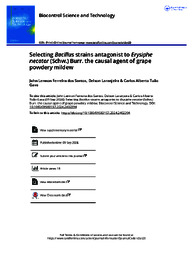Selecting Bacillus strains antagonist to Erysiphe necator (Schw.) Burr. the causal agent of grape powdery mildew.
Selecting Bacillus strains antagonist to Erysiphe necator (Schw.) Burr. the causal agent of grape powdery mildew.
Author(s): SANTOS, J. L. F. dos; LARANJEIRA, D.; GAVA, C. A. T.
Summary: Grape powdery mildew (GPM) control is based on the preventive use of sulfur and curative application of synthetic fungicides, increasing the risk for producers’ health and environmental and fruit contamination. This work aimed to select Bacillus strains isolated from the Brazilian tropical semi-arid region that are effective antagonists to GPM. In an initial screening performed by spraying bacterial suspensions in detached grape leaves, six strains of Bacillus spp. showed disease symptom reduction higher than 70.0%. Two greenhouse experiments showed that the bacterial strains LCB03, LCB28, and LCB30 showed control efficiency >80%, statistically similar to a commercial formulation with Bacillus amyloliquefaciens QST713. 16s rDNA sequencing showed that strain LCB03 showed 100.0% homology to B. velezensis, while LCB28 has high homology to B. tequillensis (99.93%), and LCB30 had 99.71% homology with B. siamensis. As an average for both greenhouse experiments, weekly application of Bacillus sp LCB03, Bacillus sp LCB28, and Bacillus sp. LCB30 reduced the average incidence by around 50% and more than 80% for GPM severity.
Publication year: 2024
Types of publication: Journal article
Unit: Embrapa Semi-arid Region
Keywords: Antagonismo, Bacillus antagonistas, Bacillus sp, Biocontrole, Doença, Erysiphe necator, Grapes, Oídio, Oídio da uva, Powdery mildew, Uva
Observation
Some of Embrapa's publications are published as ePub files. To read them, use or download one of the following free software options to your computer or mobile device. Android: Google Play Books; IOS: iBooks; Windows and Linux: Calibre.
Access other publications
Access the Agricultural Research Database (BDPA) to consult Embrapa's full library collection and records.
Visit Embrapa Bookstore to purchase books and other publications sold by Embrapa.

